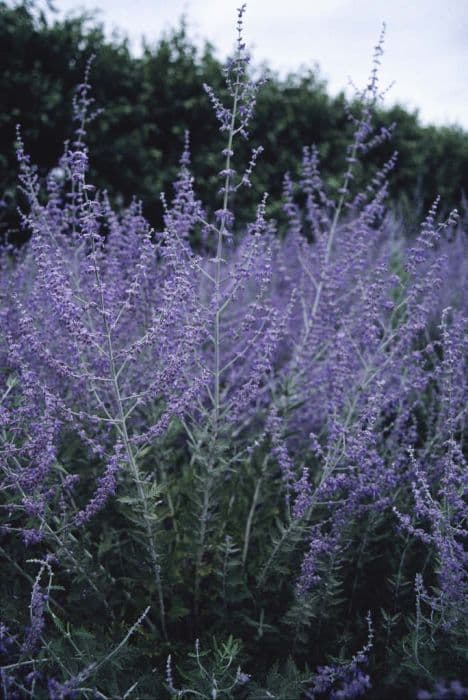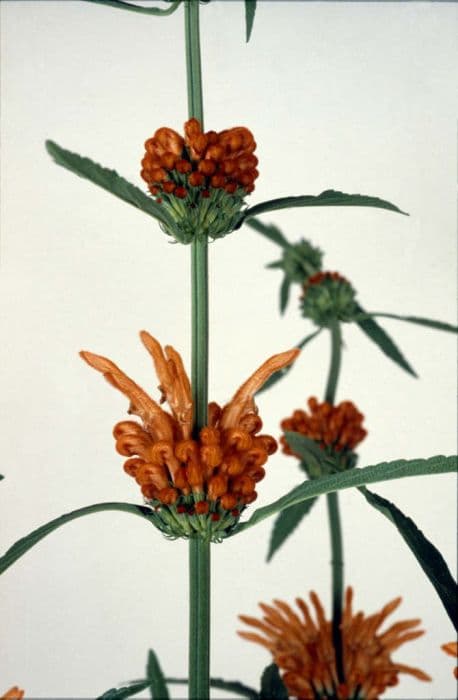Perovskia Salvia 'Blue Spire' (Pe)

ABOUT
Salvia 'Blue Spire', also known as Perovskia, is a striking plant that boasts an attractive contrast of color and texture. Its appearance is characterized by a profusion of small, tubular deep blue or violet flowers that create a visually appealing effect. These blossoms are tightly packed into long, slender, and upright flower spikes, which bloom from midsummer to fall and are especially eye-catching when swaying gently in the breeze. The foliage of Perovskia is also noteworthy, presenting a delicate grayish-green color with a fine, lace-like texture. The leaves typically have a deeply incised shape, with a jagged or toothed edge, and they are often covered with fine hairs, giving them a soft, almost silvery look. The combination of these frosted leaves against the vibrant blue flowers is one of the plant's most distinctive features. Perovskia's overall form is that of a loosely branched shrub, with stems that tend to be square and sometimes show a hint of purple or white frosting. The plant's structure creates an airy and open appearance that can add depth and lightness to garden compositions. It is a hardy and resilient plant, often used in borders or as a focal point in garden designs due to its dynamic visual appeal and long blooming period.
About this plant
 Names
NamesSynonyms
Perovskia, Russian Sage, Afghan Sage
Common names
Perovskia atriplicifolia 'Blue Spire', Salvia yangii 'Blue Spire'
 Toxicity
ToxicityTo humans
The plant commonly known as Russian Sage is generally considered non-toxic to humans. However, it's always wise to avoid ingesting any plant parts if you are not certain of their edibility and safety, as individual reactions can vary. Browsing through credible sources and available scientific literature, there are no widespread reports of poisoning from Russian Sage. Ingesting any part of this plant typically does not lead to any known significant toxic consequences for humans.
To pets
Russian Sage is also considered non-toxic to pets. This means that ingestion of this plant should not typically result in any serious symptoms of poisoning in animals such as dogs or cats. While it is not common for pets to experience adverse effects from contact with or ingestion of Russian Sage, it is still advisable to prevent pets from consuming any plants in large quantities, as individual sensitivities can occur, which might lead to mild gastrointestinal upset.
 Characteristics
CharacteristicsLife cycle
Perennials
Foliage type
Deciduous
Color of leaves
Green
Flower color
Blue
Height
3 feet (0.91 meters)
Spread
2 feet (0.61 meters)
Plant type
Shrub
Hardiness zones
5
Native area
Central Asia
Benefits
 General Benefits
General Benefits- Aesthetic Appeal: Salvia 'Blue Spire' adds striking blue and purple hues to gardens, contributing to a visually appealing landscape.
- Attracts Pollinators: The plant is known to attract bees, butterflies, and other beneficial pollinators, which are essential for a healthy ecosystem and for the pollination of other plants.
- Drought Tolerance: Once established, it is considered drought-tolerant, reducing the need for frequent watering and making it suitable for xeriscaping.
- Easy Maintenance: It requires minimal care and is resistant to many pests and diseases, making it an easy choice for both novice and experienced gardeners.
- Herbaceous Perennial: Being a perennial, it will come back each year, providing a long-lasting addition to the garden with less replanting effort.
- Culinary Use: The leaves can sometimes be used in cooking for an added savory flavor, though this is not the primary use of this ornamental plant.
- Deer Resistance: Salvia 'Blue Spire' is generally resistant to deer, which can be beneficial in areas where deer predation on plants is a concern.
 Medical Properties
Medical Properties- Anti-inflammatory: Contains compounds that may reduce inflammation in the body.
- Antioxidant: Possesses antioxidant properties that may help protect against cellular damage.
- Anti-anxiety: Traditionally used to help calm nerves and reduce anxiety symptoms.
- Cognitive enhancement: Some constituents may potentially improve memory and cognitive function.
 Air-purifying Qualities
Air-purifying QualitiesThis plant is not specifically known for air purifying qualities.
 Other Uses
Other Uses- As a natural dye: The leaves of the Russian Sage may be used to produce a subtle greenish dye for fabrics or paper.
- Culinary flavoring: Although not commonly used, the leaves can impart a sage-like flavor to dishes and can be used sparingly in recipes.
- Companion planting: Russian Sage is known to repel deer and rabbits, making it a good companion plant in gardens to protect other plants.
- Crafting: Its woody stems can be dried and used in floral arrangements or wreaths for an aromatic and long-lasting decoration.
- Garden structure: The tall and upright habit of Russian Sage can provide structural interest in the winter garden after the plant has finished blooming and lost its leaves.
- Natural insect repellent: The strong aromatic properties of Russian Sage can deter insects when planted in a garden or when its leaves are used in sachets.
- Homemade potpourri: Dried leaves and flowers can be mixed with other botanicals to create fragrant potpourri.
- Artistic inspiration: The striking blue flowers and silvery foliage are often used as inspiration or actual subjects in botanical illustration and photography.
- Erosion control: Its extensive root system can help to stabilize soil on slopes or areas prone to erosion.
- Fragrance production: While not a traditional source, its essential oils could potentially be used in perfumery for a unique, herbaceous note.
Interesting Facts
 Feng Shui
Feng ShuiThe Russian Sage is not used in Feng Shui practice.
 Zodiac Sign Compitability
Zodiac Sign CompitabilityThe Russian Sage is not used in astrology practice.
 Plant Symbolism
Plant Symbolism- Healing: Salvia, often referred to as sage, has traditionally been associated with healing properties. 'Blue Spire' may symbolize health and well-being.
- Wisdom: With its common name sage, this plant is often linked to wisdom and intelligence, as the word 'sage' also means a wise person.
- Longevity: Sage plants in general are seen as symbols of long life and immortality, which could extend to 'Blue Spire' as well.
- Cleansing: Sage has been used in smudging practices for purification, thus 'Blue Spire' may carry the symbolic meaning of cleansing and clearing negative energy.
- Protection: Associated with protection, sage is often believed to ward off evil and provide a safe space, which can be symbolically inferred for 'Blue Spire' too.
 Water
WaterThe Russian Sage should be watered deeply, allowing the soil to dry out between watering sessions to prevent root rot. During the growing season—spring and summer—watering typically involves 1 inch of water per week, depending on rainfall and soil conditions. In periods of drought or extreme heat, you may need to increase watering frequency. Reduce watering in the fall and even more so in the winter when the plant is dormant. An established Russian Sage may require watering only once every 2 to 3 weeks, depending on the climate and soil moisture. Always check the top 2 to 3 inches of soil for dryness before watering again.
 Light
LightRussian Sage thrives best in full sun, meaning it should receive at least 6 to 8 hours of direct sunlight each day. A spot that provides unobstructed sunlight, away from the shade of larger trees or buildings, will ensure the plant produces abundant flowers and maintains healthy growth. Russian Sage can tolerate some light shade, but flowering and foliage robustness may be compromised.
 Temperature
TemperatureRussian Sage performs admirably in a range of temperatures but the ideal growing conditions are within the 60°F to 70°F range. It can tolerate maximum temperatures well above 80°F and can survive winter lows down to about -20°F. Plant hardiness zones for Russian Sage typically range from 5 through 9.
 Pruning
PruningPrune Russian Sage in the late winter or early spring before new growth starts. This helps maintain a tidy shape, encourages new growth, and can refresh an older plant that might have become woody. Pruning is also an opportunity to cut back any damaged or excessively long stems. Annual pruning of about one-third to one-half of the plant is recommended, as it responds well to being cut back and can become too large if left unpruned.
 Cleaning
CleaningAs needed
 Soil
SoilRussian Sage prefers well-draining soil with a pH between 6.0 and 7.0. A mix with loamy soil, compost, and coarse sand is ideal to achieve the right drainage and fertility.
 Repotting
RepottingRussian Sage does not typically need frequent repotting. It should be repotted every 3 to 4 years to refresh the soil and accommodate root growth.
 Humidity & Misting
Humidity & MistingRussian Sage is tolerant of a wide range of humidity levels and does well in average ambient humidity, without the need for any special humidity adjustments.
 Suitable locations
Suitable locationsIndoor
Place in a sunny spot, minimal care, well-draining soil.
Outdoor
Full sun, well-drained soil, drought-tolerant once established.
Hardiness zone
5-9 USDA
 Life cycle
Life cycleSalvia 'Blue Spire', commonly known as Perennial Sage, begins its life cycle as a seed, which upon germination, develops into a small seedling with characteristic foliage. As it grows, the plant enters a vegetative stage, producing a rosette of leaves during the first season, followed by a more robust development of stems and foliage in subsequent years. In spring or early summer, Perennial Sage transitions to the reproductive stage, where it forms tall spikes of violet-blue flowers that attract bees, butterflies, and hummingbirds. After pollination, if seeds are produced, they will mature as the flowering spikes fade and dry out by late summer or early fall. Once the seeds are dispersed, the plant begins to prepare for dormancy, with foliage dying back in response to colder temperatures and shorter days. The plant overwinters as a crown with root system intact, ready to restart the cycle with new growth the following spring.
 Propogation
PropogationPropogation time
Spring to early summer
Propogation: The ideal time to propagate Russian Sage, known botanically as Salvia 'Blue Spire', is during the spring or early summer when the plant is actively growing. The most popular method of propagation for this plant is by softwood cuttings. To do this, you select a healthy, non-flowering shoot and cut a 3 to 5 inch (approximately 7.5 to 12.5 cm) section just below a node. The lower leaves are then removed, and the cutting may be dipped in rooting hormone to increase the chances of successful rooting. The cutting should be placed in a well-draining soil mix and kept in a warm, humid environment with bright, indirect light. Roots typically develop within a few weeks, after which the new plant can be gradually acclimatized to typical growing conditions before being transplanted outdoors.









